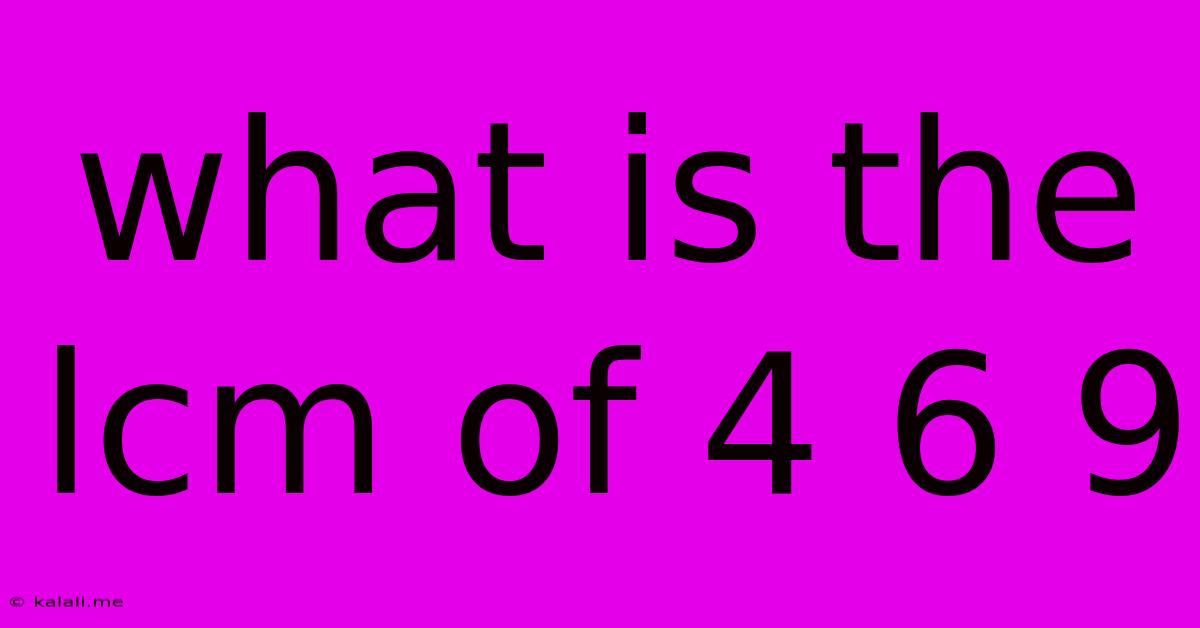What Is The Lcm Of 4 6 9
Kalali
Jun 16, 2025 · 2 min read

Table of Contents
What is the LCM of 4, 6, and 9? Finding the Least Common Multiple
Finding the least common multiple (LCM) is a fundamental concept in mathematics, particularly useful in arithmetic, algebra, and even more advanced fields. This article will guide you through the process of determining the LCM of 4, 6, and 9, explaining the methods involved and providing a clear understanding of the concept. Understanding LCM is crucial for solving various mathematical problems, including simplifying fractions and solving equations.
What is the Least Common Multiple (LCM)?
The least common multiple (LCM) of two or more integers is the smallest positive integer that is divisible by all the integers. In simpler terms, it's the smallest number that all the given numbers can divide into evenly. This differs from the greatest common divisor (GCD), which is the largest number that divides all the given numbers without leaving a remainder.
Methods for Finding the LCM of 4, 6, and 9
There are several methods to calculate the LCM, and we'll explore two common approaches:
1. Prime Factorization Method
This method involves breaking down each number into its prime factors. Prime factors are numbers that are only divisible by 1 and themselves (e.g., 2, 3, 5, 7, etc.).
- Prime factorization of 4: 2 x 2 = 2²
- Prime factorization of 6: 2 x 3
- Prime factorization of 9: 3 x 3 = 3²
Now, identify the highest power of each prime factor present in the factorizations:
- The highest power of 2 is 2²
- The highest power of 3 is 3²
To find the LCM, multiply these highest powers together:
2² x 3² = 4 x 9 = 36
Therefore, the LCM of 4, 6, and 9 is 36.
2. Listing Multiples Method
This method is more straightforward for smaller numbers. We list the multiples of each number until we find the smallest multiple common to all three.
- Multiples of 4: 4, 8, 12, 16, 20, 24, 28, 32, 36, 40...
- Multiples of 6: 6, 12, 18, 24, 30, 36, 42...
- Multiples of 9: 9, 18, 27, 36, 45...
The smallest number that appears in all three lists is 36. This confirms our result from the prime factorization method.
Applications of LCM
Understanding LCM has practical applications in various real-world scenarios, including:
- Fraction addition and subtraction: Finding a common denominator for fractions requires calculating the LCM of the denominators.
- Scheduling: Determining when events will occur simultaneously (e.g., buses arriving at the same stop).
- Measurement conversions: Converting between different units of measurement.
Conclusion
Finding the least common multiple is a valuable skill with broad applications. Both the prime factorization and listing multiples methods are effective, with prime factorization being generally more efficient for larger numbers. Remember that the LCM of 4, 6, and 9 is 36, a number divisible by all three without leaving a remainder. Understanding this fundamental concept enhances your mathematical problem-solving abilities.
Latest Posts
Latest Posts
-
Friction Factor Formula For Laminar Flow
Jun 16, 2025
-
Select The True Statements About Sending Information On The Internet
Jun 16, 2025
-
List The Criteria For Effective Taxes
Jun 16, 2025
-
Electric Field Inside Non Conducting Sphere
Jun 16, 2025
-
The Kilowatt Is A Unit Of
Jun 16, 2025
Related Post
Thank you for visiting our website which covers about What Is The Lcm Of 4 6 9 . We hope the information provided has been useful to you. Feel free to contact us if you have any questions or need further assistance. See you next time and don't miss to bookmark.